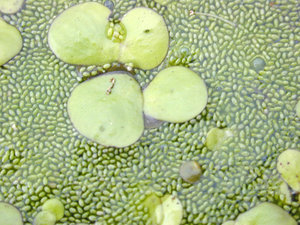Lemnaceae
|
|
| Duckweed family | ||||||||||
|---|---|---|---|---|---|---|---|---|---|---|
 Close up of two different duckweeds: Spirodela polyrrhiza and Wolffia globosa. The very tiny Wolffia plants are under 2 mm long</small> | ||||||||||
| Scientific classification | ||||||||||
| ||||||||||
| Genera | ||||||||||
Lemnaceae, or the Duckweed family, is a family of monocot flowering plants containing the duckweeds (also known as water lentils).
These plants are very simple, lacking a stem or leaves, but consisting of a small blade-like structure floating on or just under the water surface, with or without simple rootlets. Reproduction is mostly by budding, but occasionally a flower consisting of two stamens and a pistil (some call it an inflorescence with three unisexual flowers) is produced. The fruit is an utricle, a sac containing air and a seed designed to float. The flower of Wolffia is the smallest in the world at 0.3 mm long.
Lemna_minor3.jpg
The family contains five genera and 38 species and believed to be descended from a plant similar to Pistia in the Family Araceae.
Duckweeds are an important food source for waterfowl and are eaten by humans in parts of Southeast Asia (as khai-nam). Some duckweeds are used in freshwater aquariums and ponds where they may spread rapidly, although in a large pond may be difficult to eradicate once established. The plants can provide nitrate removal (if cropped) and cover for fry.
Reference and external link
- Wayne Armstrong's treatment of the Lemnaceae (http://waynesword.palomar.edu/1wayindx.htm).
Template:Commons Template:Commonsda:Andemad-familien (Lemnaceae) es:Lemnaceae eo:Lemnacoj fr:Lemnacée ja:ウキクサ科 lt:Plūdeniniai augalai nl:Eendenkroosfamilie pl:Rzęsa drobna zh:浮萍科
